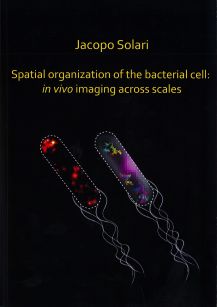Spatial organization of the bacterial cell: in vivo imaging across scales
Bacteria are amongst the smallest known living organisms and yet they carry out an incrediblevariety of different functions and are able to respond to a large variety of different externalstimuli. Growing evidence is suggesting that specific proteins and sub-cellular components(e.g. the nucleoid) need to be highly organized both on the membrane and inside the cellularvolume in order to carry out vital tasks like cell replication or chemotaxis and to respond toexternal changes in the environment. In this thesis I investigated experimentally the spatialorganization of different sub-cellular components (nucleoid) and protein species (NAPs andchemoreceptors) and its importance for physiological processes inside living bacterial cells.Most of the experiments presented here are carried out in living cells, and our results thusprovide insights also into the spatio-temporal organization and the dynamics of the responseto controlled perturbations.



